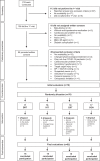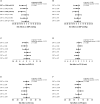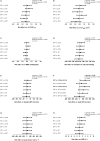Effects of dynamic, isometric and combined resistance training on blood pressure and its mechanisms in hypertensive men
- PMID: 36759659
- PMCID: PMC9909153
- DOI: 10.1038/s41440-023-01202-4
Effects of dynamic, isometric and combined resistance training on blood pressure and its mechanisms in hypertensive men
Abstract
Although dynamic resistance training (DRT) and isometric handgrip training (IHT) may decrease blood pressure (BP) in hypertensives, the effects of these types of training have not been directly compared, and a possible additive effect of combining IHT to DRT (combined resistance training-CRT), has not been investigated. Thus, this study compared the effects of DRT, IHT and CRT on BP, systemic hemodynamics, vascular function, and cardiovascular autonomic modulation. Sixty-two middle-aged men with treated hypertension were randomly allocated among four groups: DRT (8 exercises, 50% of 1RM, 3 sets until moderate fatigue), IHT (30% of MVC, 4 sets of 2 min), CRT (DRT + IHT) and control (CON - stretching). In all groups, the interventions were administered 3 times/week for 10 weeks. Pre- and post-interventions, BP, systemic hemodynamics, vascular function and cardiovascular autonomic modulation were assessed. ANOVAs and ANCOVAs adjusted for pre-intervention values were employed for analysis. Systolic BP decreased similarly with DRT and CRT (125 ± 11 vs. 119 ± 12 and 128 ± 12 vs. 119 ± 12 mmHg, respectively; P < 0.05), while peak blood flow during reactive hyperaemia (a marker of microvascular function) increased similarly in these groups (774 ± 377 vs. 1067 ± 461 and 654 ± 321 vs. 954 ± 464 mL/min, respectively, P < 0.05). DRT and CRT did not change systemic hemodynamics, flow-mediated dilation, and cardiovascular autonomic modulation. In addition, none of the variables were changed by IHT. In conclusion, DRT, but not IHT, improved BP and microvascular function in treated hypertensive men. CRT did not have any additional effect in comparison with DRT alone.
Keywords: Autonomic modulation; Hemodynamics; Hypertension; Strength training; Vascular function.
© 2023. The Author(s), under exclusive licence to The Japanese Society of Hypertension.
Conflict of interest statement
The authors declare no competing interests.
Figures



Comment in
-
Hypotensive effects of resistance training in treated hypertensive men: Is the systemic dynamic mode better than the isometric handgrip mode?Hypertens Res. 2023 Jun;46(6):1612-1614. doi: 10.1038/s41440-023-01274-2. Epub 2023 Apr 10. Hypertens Res. 2023. PMID: 37037917 No abstract available.
References
-
- Whelton PK, Carey RM, Aronow WS, Ovbiagele B, Casey DE, Smith SC, et al. 2017 ACC / AHA / AAPA / ABC / ACPM / AGS / APhA / ASH / ASPC / NMA / PCNA Guideline for the Prevention, Detection, Evaluation, and Management of High Blood Pressure in Adults A Report of the American College of Cardiology / American Heart Association T. Hypertension. 2018;71:1269–324. doi: 10.1161/HYP.0000000000000066. - DOI - PubMed
Publication types
MeSH terms
LinkOut - more resources
Full Text Sources
Medical
Research Materials
Miscellaneous

